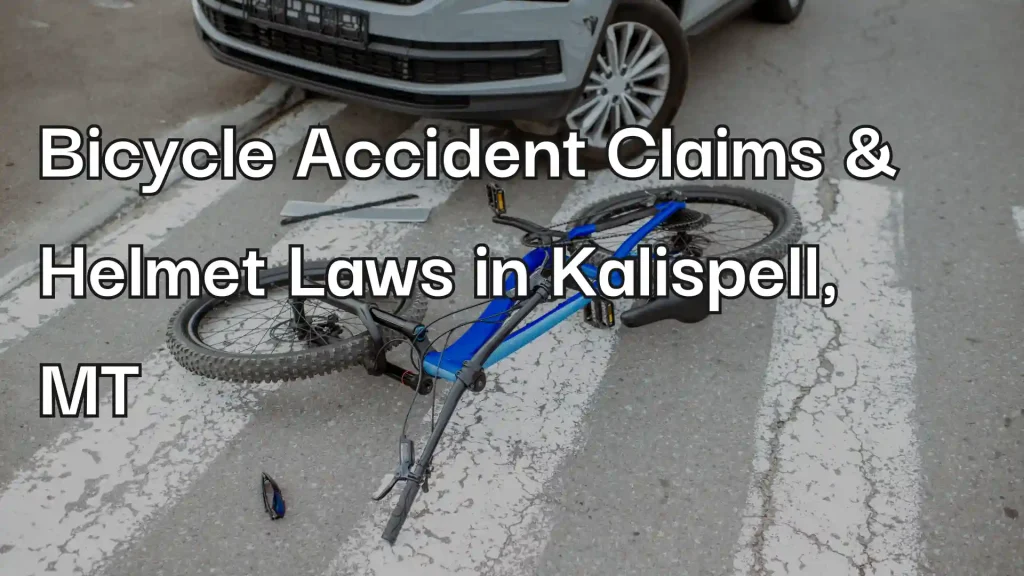
Kalispell, Montana, offers breathtaking views, some of which are best experienced from a bicycle seat. Little wonder, then, why so many residents and visitors are opting to hit the road on two wheels. After all, beyond the views, bicycling also offers health benefits for both riders and the natural environment. However, it’s important to be aware of bicycle accident helmet laws in the area to ensure your safety while enjoying the ride.
Before you hitch up your pant leg and hop on the saddle, you should familiarize yourself with the traffic rules and regulations for cyclists. Doing so is important not only for your own safety but also for the safety of others. So, let’s explore these rules in detail, including helmet laws—and explain what you can do if you’re ever in an accident.
Bicycle Accident Statistics
Before we explore Montana’s bicycling rules, we should examine why they’re so important. The National Highway Traffic Safety Administration estimates that in one year, nearly 940 cyclists lost their lives in traffic fatalities nationwide, and another roughly 38,900 cyclists were injured. Although Montana boasts incredible views and natural scenery, it has been ranked as one of the least bicycle-friendly states in the nation by The League of American Bicyclists. A lack of infrastructure, traffic laws, and harsh winters are only a few reasons Big Sky Country is a problem for bicyclists.
To make the state safer for bicyclists, the Montana Department of Transportation has a resource page just for them. It has info about state bike laws, commuting tips, bicycle routes, weather forecasts, and additional resources to get travelers and locals excited and informed about biking in Montana.
Montana Bicycle Laws
In Montana, bicyclists must follow many of the same traffic rules and regulations as motorized vehicles. For example, cyclists must obey all traffic signs and signals, just like drivers of cars and trucks. Additionally, specific codes apply only to those navigating Montana on bicycles, including bicycle accident helmet laws. Among these are the following:
-
The law prohibits cyclists from holding or attaching themselves to any vehicle on Montana roadways.
-
Bicyclists traveling at a speed that is less than normal traffic must use the right-hand lane when it is safe.
-
Bicycles must be equipped with brakes that allow them to stop within 25 feet of a speed of 10 miles per hour.
-
Cyclists in crosswalks and sidewalks must yield the right-of-way to pedestrians and give an audible signal when overtaking pedestrians.
-
Bicycle racing is prohibited on highways unless approved by local or state authorities.
-
Bicyclists cannot carry objects, which prevents them from keeping at least one hand on the bike’s handlebars.
Additional legal requirements exist for cyclists traveling on Montana roadways at dawn, dusk, and night. Any bicycle ridden at these times must be equipped with a front headlamp and rear red light visible for up to 500 feet and reflective material on the left and right sides that can be seen at a distance of at least 500 feet.
Montana’s Helmet Laws
Wearing a safety helmet can save your life. Studies show that helmets can reduce head injuries by 48 percent and serious head injuries by at least 60 percent. Cyclists should choose a snug-fitting helmet with a securely fitting chin strap. Helmets should not be loose or wiggled around when on the head but should not be tight enough to cause discomfort or headaches. Avoid “novelty” helmets and look for helmets approved by the Consumer Product Safety Commission.
Impact of Helmet Use on Injury Claims
Although helmets are not required by law, failing to protect yourself by wearing proper safety gear increases your chance of injury in a traffic collision. Moreover, it can also complicate any personal injury claim against a driver who hits you.
Montana’s Fault-Based Insurance System
Montana follows a traditional fault-based car insurance system. This means that the person who causes an accident pays for its consequences. If a careless driver hits and injures a cyclist, the cyclist can seek compensation by filing a claim with the driver’s insurance provider. Alternatively, they could pursue a personal injury lawsuit against the driver.
Here’s where things get complicated. Montana also follows what’s called a modified comparative negligence rule. Under this rule, a court hearing a personal injury case will assign each party a percentage of fault based on how that party contributed to the accident. The court then reduces whatever compensation the injured party recovers in proportion to their share of fault. To illustrate this principle, let’s say the court hearing a bicycle accident case assigns the injured cyclist 20 percent of the blame and the motorist the other 80 percent. If the cyclist’s award had otherwise been $50,000, they would have actually recovered $40,000—that is, 80 percent of $50,000.
At this point, you might be wondering how helmets fit into this equation. Here’s how: because an effective attorney could argue that a bicycle rider who fails to protect themselves by wearing a helmet bears some responsibility for the severity of their injuries. Therefore, they would argue that the court should reduce the value of your compensation.
Courts are bound by modified comparative negligence, but insurance companies are not. However, the rule still guides how an insurance adjuster can value a claim. An insurance company can use the same logic, arguing that because you didn’t take safety precautions to minimize injury, like wearing a helmet, they should not be on the hook for all your medical expenses.
You need an equally aggressive attorney advocating for you and fighting back against these attempts to get out of paying you fairly. An attorney can gather valuable evidence and show that the only reason you suffered injuries at all was because of the driver who hit you.
Common Bicycle Accident Injuries
Motorists are surrounded by nearly 3,000 pounds of metal and fiberglass. They also benefit from safety features like seat belts and airbags. Bicyclists have helmets on their heads and clothes on their backs for protection. Unfortunately, when a motorist hits a cyclist, the consequences can be catastrophic, leaving the cyclist with injuries like:
- Traumatic brain injury
- Paralysis
- Amputations
- Neck and spine injuries
- Broken bones
- Facial injuries
- Dental injuries
- Road rash
- Burns
- Soft tissue damage
- Internal bleeding
- Abrasions
- Lacerations
- Contusions
Emotional and psychological injuries are also common after traumatic cycling accidents. Depression, anxiety, insomnia, and post-traumatic stress syndrome can develop weeks or even months after a collision. In the event of a bicycle accident, be sure to contact law enforcement for help and seek medical attention immediately.
Common Causes of Bicycle Accidents
Driver error and poor visibility are among the leading causes of Montana bicycle accidents. Cyclists are smaller than motor vehicles and consequently harder to see, especially when drivers are not paying attention to their surroundings. Other dangerous driving behaviors that lead to accidents include:
- Impaired driving
- Driver fatigue
- Speeding
- Opening doors without looking
- Failing to yield
- Aggressive driving
- Failing to follow traffic signs and signals
- Turning into crosswalks without looking
- Making unsafe left-hand turns
Bicycle accidents can also be caused by low light conditions, bad weather, mechanical defects, and poor road conditions.
Montana Bicycle Safety Tips
You can proactively protect yourself as you explore Montana on your bicycle. Here are some important safety tips to follow:
-
Review and obey all Montana traffic laws
-
Wear a helmet that meets Consumer Product Safety Commission standards
-
Wear bright colors and reflective materials
-
Check your bike before you ride, and always keep it in good working order
-
Make sure your bike is the right size for you and your preferred riding conditions
-
Never ride against the flow of traffic
-
Avoid distractions and stay alert
-
Use hand signals to communicate with drivers and pedestrians
-
Use caution when making left turns
-
Always use lights when cycling at night
-
If you need to transport items regularly, use a rack over the rear wheel so your hands always remain safely on the handlebars
The Montana Department of Transportation also has resources to help riders choose routes and trails, find repair shops, and check weather conditions before they ride.
A Kalispell, Montana Bicycle Accident Attorney Can Help
Call us today at (406) 752-7550 and request a complimentary case evaluation. Our compassionate team can review your situation and outline your legal options for recovering the money you need.
Related Posts:
Rental Car Cost Coverage After an Accident Explained
Why You Shouldn’t Handle a Slip-and-Fall Case on Your Own
The Importance of Legal Representation After a Workplace Injury

